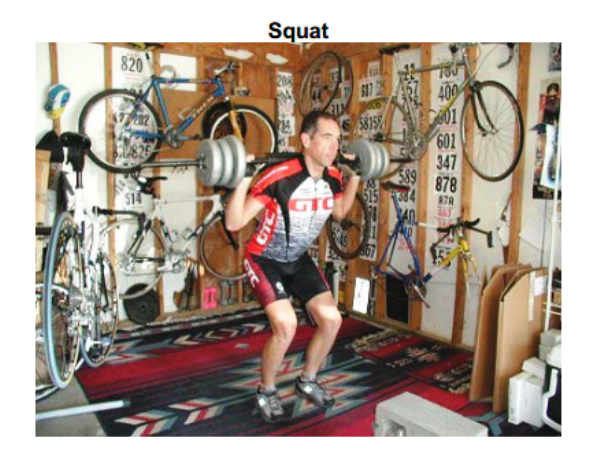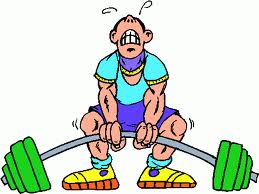How to Combat the Effects of Ageing
 As we age, keeping healthy, fit and strong becomes more important. There is now a lot of research into ageing, and how the effects can be slowed down. These effects were highlighted in my previous posting Are You Past 40, or Just Past It? The problem is loss of muscle mass, or to give it its proper name, sarcopenia, and the answer is strength training.
As we age, keeping healthy, fit and strong becomes more important. There is now a lot of research into ageing, and how the effects can be slowed down. These effects were highlighted in my previous posting Are You Past 40, or Just Past It? The problem is loss of muscle mass, or to give it its proper name, sarcopenia, and the answer is strength training.
Strength (resistance) training is also becoming increasingly popular as a means of improving cycle fitness, especially during the winter off-season The claimed benefits are that increased leg strength improves not just hill climbing, but also endurance.
Strength training is practised by Sir Bradley Wiggins, Mark Cavendish and other top Tour and and Olympic cyclists, would it also benefit you?
The rationale for Strength Training is that whilst cycling is an endurance sport it also requires strength to power the pedals. It has been shown that resistance training builds strength and that increased strength also helps to build endurance. A win, win, outcome!
There is evidence that strength training has additional benefits for all cyclists, but especially for veteran cyclist. For example, it is suggested that cyclists have less bone strength than other athletes, perhaps due to the lack of impact on bones such as with running. Whether or not this is true, resistance training has been proven to improve bone strength (to safeguard against osteoporosis) as well as muscular strength.
A more important benefit as you age is that resistance training, especially if you lift fairly heavy weights, will reduce the effects of sarcopenia. This age related loss of muscle mass will occur even though you might be a regular bike rider. Resistance training has been proven to slow down this natural ageing process.
Ideally you should follow an exercise programme covering all the major muscle groups, but there is one exercise which is claimed to be the “King” of all strength building exercises. It also happens to be an exercise which is particularly beneficial for cyclists!
This exercise is the Squat.


When standing up out of a squat it mimics the downward pedal stroke motion very well. That’s why it is such a good exercise for cyclists. Note the straight back in the two photos. Very important in order to avoid injury, especially when using additional weight!
Strength-Endurance Training: When pedaling you only use a fraction of your absolute leg strength with each pedal stroke but do thousands of reps per ride. So for cyclists strength-endurance is more about endurance and less about strength, but strength gains will increase endurance and certainly improve your hill climbing!
For strength endurance, light resistance can be used so squats can be performed with only body weight as the resistance. So no need to go to the gym. Body weight squats are bebeficial
The article suggests that improving your strength-endurance requires fairly high reps with moderate weights. It prescribes 30-50 reps per set of Squats This sounds huge to a typical weight lifter, but when you consider you normally do thousands of pedal reps, 50 isn’t that many. But the force required for each rep is considerably higher than pedalling a bike, even going uphill.
No time for the rest period between sets is mentioned. I would suggest 60 to 90 seconds when you are using light resistance.
At the beginning of this leg strength training, you want to ease into it gradually, otherwise your legs will be extremely sore. So start off strength-endurance training with body weight or an additional very light weight. You can increase body weight resistance by wearing a loaded rucksack, sand in plastic bags make additional weight variations easy!
If you own a set of weights or intend to be a bit more adventurous, start off light. The article suggests that the first time just use the bar and do 2-3 sets of 15 reps. It’s amazing how sore you may feel the next day. (I did, hamstrings, for three days after!). Once over the initial shock, your muscles will respond quickly and you will be able to increase the weight quite fast. Work your way up gradually to 5 sets of 50 reps if you have the time and inclination!
When using heavier weights you may need to increase rest periods between sets, say 90 seconds to 2 minutes.
If I miss a club ride for any reason I substitute with a Squats training session. In addition, as I normally ride twice a week (Sunday and Tuesday Rides), I do Squats on at least one other day, Thursday or Friday. So if I was unable to get out on my bike on both Sunday and Tuesday I would do 3 days of Squat training.
A modification that I have made to suit me, is that I now try to do 6 sets of 50 reps. These I do as 3 sets in the morning and 3 sets in the evening (a split routine is supposed to have added benefits). If I have other commitments so am pushed for time, I have the option of just doing either the morning or evening session.
suited to In this item I am just referring to resistance training for the cyclists legs and core muscle groups.Looking for advice and inspiration I came across an interesting discourse on this very subject. The full length article can be readvia this link . However I am just going to refer to a small part of this lengthy and detailed article. The small bit that I have decided to try out related to only one of the suggested exercises, and only one of several training routines, that is training for Strength – Endurance.
But is it working for me? Early days yet, but so far so good!
The exercise: The Squat is considered to be the king of strength building exercises. This is because by working many of the most important muscle groups it builds overall strength. It also happens to be a perfect exercise for cyclists!
When standing up out of a squat it mimics the downward pedal stroke motion very well. It helps to avoid muscular imbalance by simultaneously strengthing both quads and glutes. That’s why it is such a good exercise for cyclists.
For strength endurance, light resistance can be used so squats can be performed with only body weight as the resistance. So no need to go to the gym!
Note the straight back in the photo below. Very important in order to avoid injury, especially when using additional weight!

Strength-Endurance Training: When pedaling you only use a fraction of your absolute leg strength with each pedal stroke but do thousands of reps per ride. So for cyclists strength-endurance is more about endurance and less about strength, but strength gains will increase endurance.
The article suggests that improving your strength-endurance requires fairly high reps with moderate weights. It prescribes 30-50 reps per set of Squats This sounds huge to a typical weight lifter, but when you consider you normally do thousands of pedal reps, 50 isn’t that many. But the force required for each rep is considerably higher than pedalling a bike, even going uphill.
No time for the rest period between sets is mentioned. I would suggest 60 to 90 seconds when you are using light resistance.
At the beginning of this leg strength training, you want to ease into it gradually, otherwise your legs will be extremely sore. So start off strength-endurance training with body weight or an additional very light weight. You can increase body weight resistance by wearing a loaded rucksack, sand in plastic bags make additional weight variations easy!

If you own a set of weights or intend to be a bit more adventurous, start off light. The article suggests that the first time just use the bar and do 2-3 sets of 15 reps. It’s amazing how sore you may feel the next day. (I did, hamstrings, for three days after!). Once over the initial shock, your muscles will respond quickly and you will be able to increase the weight quite fast. Work your way up gradually to 5 sets of 50 reps if you have the time and inclination!
When using heavier weights you may need to increase rest periods between sets, say 90 seconds to 2 minutes.
If I miss a club ride for any reason I substitute with a Squats training session. In addition, as I normally ride twice a week (Sunday and Tuesday Rides), I do Squats on at least one other day, Thursday or Friday. So if I was unable to get out on my bike on both Sunday and Tuesday I would do 3 days of Squat training.
A modification that I have made to suit me, is that I now try to do 6 sets of 50 reps. These I do as 3 sets in the morning and 3 sets in the evening (a split routine is supposed to have added benefits). If I have other commitments so am pushed for time, I have the option of just doing either the morning or evening session.

